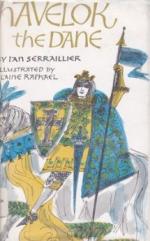This episode does not occur in the English version; but here an attack on Havelok on his return home to Denmark is made by men led by one Griffin, and this otherwise unexplainable survival of a Welsh name seems to connect the two accounts in some way that recalls the ancient legend at the back of both.
I have therefore treated the Welsh element in the story as deserving a more prominent place, at least in subsidiary incidents, than it has in the two old metrical versions. It has been possible to follow neither of these exactly, as in names and details they are widely apart; but to one who knows both, the sequence of events will, I think, be clear enough.
I have, for the same reason of the British origin of the legend, preferred the simple and apposite derivation of the name of “Curan,” taken by the hero during his servitude, from the Welsh Cwran, “a wonder,” to the Norman explanation of the name as meaning a “scullion,” which seems to be rather a guess, based on the menial position of the prince, than a translation.
For the long existence of a Welsh servile population in the lowlands of Lincolnshire there is evidence enough in the story of Guthlac of Crowland, and the type may still be found there. There need be little excuse for claiming some remains of their old Christianity among them, and the “hermit” who reads the dream for the princess may well have been a half-forgotten Welsh priest. But the mediaeval poems have Christianized the ancient legend, until it would seem to stand in somewhat the same relationship to what it was as the German “Niebelungen Lied” does to the “Volsunga Saga.”
With regard to the dreams which recur so constantly, I have in the case of the princess transferred the date of hers to the day previous to her marriage, the change only involving a difference of a day, but seeming to he needed, as explanatory of her sudden submission to her guardian. And instead of crediting Havelok with the supernatural light bodily, it has been transferred to the dream which seems to haunt those who have to do with him.
As to the names of the various characters, they are in the old versions hardly twice alike. I have, therefore, taken those which seem to have been modernized from their originals, or preserved by simple transliteration, and have set them back in what seems to have been their first form. Gunther, William, and Bertram, for instance, seem to be modernized from Gunnar, Withelm, and perhaps Berthun; while Sykar, Aunger, and Gryme are but alternative English spellings of the northern Sigurd, Arngeir, and Grim.
The device on Havelok’s banner in chapter xxi. is exactly copied from the ancient seal of the Corporation of Grimsby,[1] which is of the date of Edward the First. The existence of this is perhaps the best proof that the story of Grim and Havelok is more than a romance. Certainly the Norse “Heimskringla” record claims an older northern origin for the town than that of the Danish invasion of Alfred’s time; and the historic freedom of its ships from toll in the port of Elsinore has always been held to date from the days of its founder.




